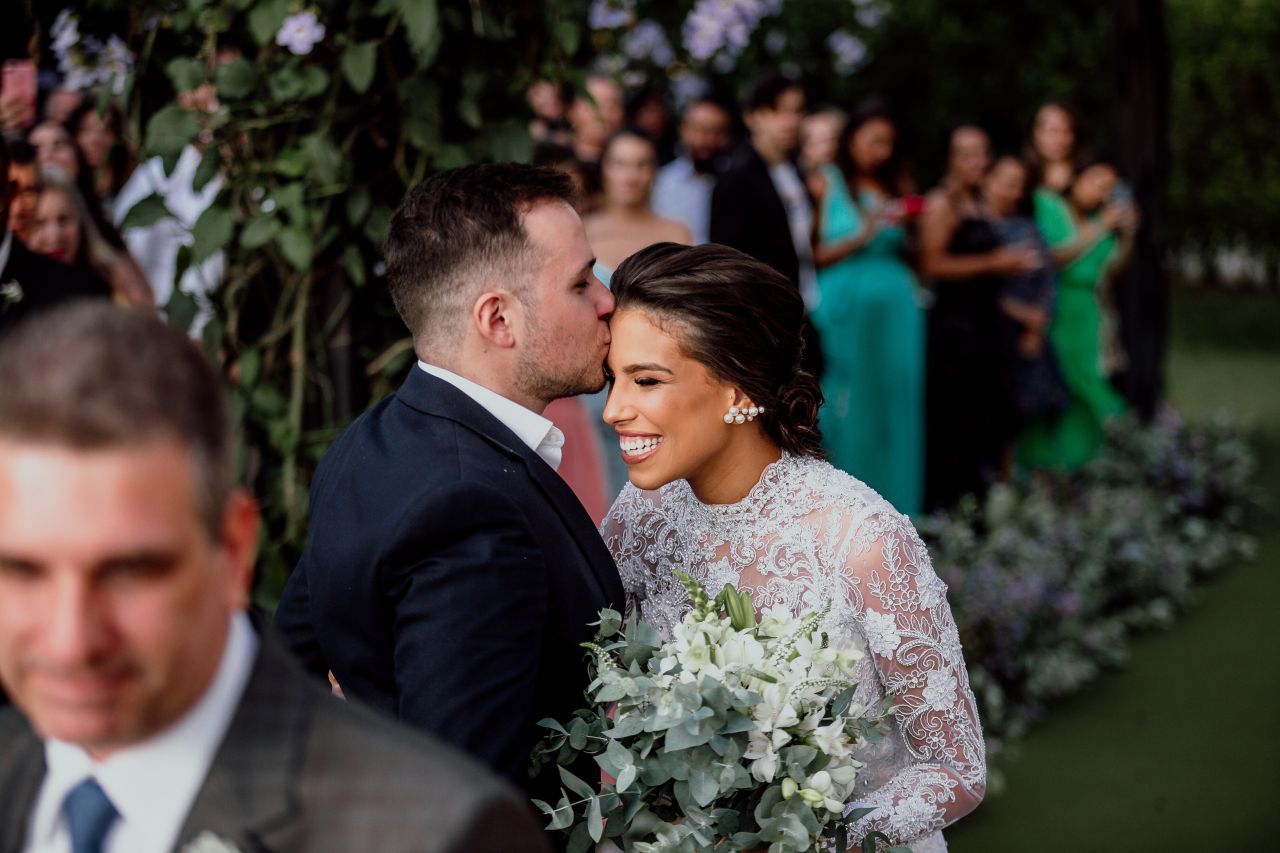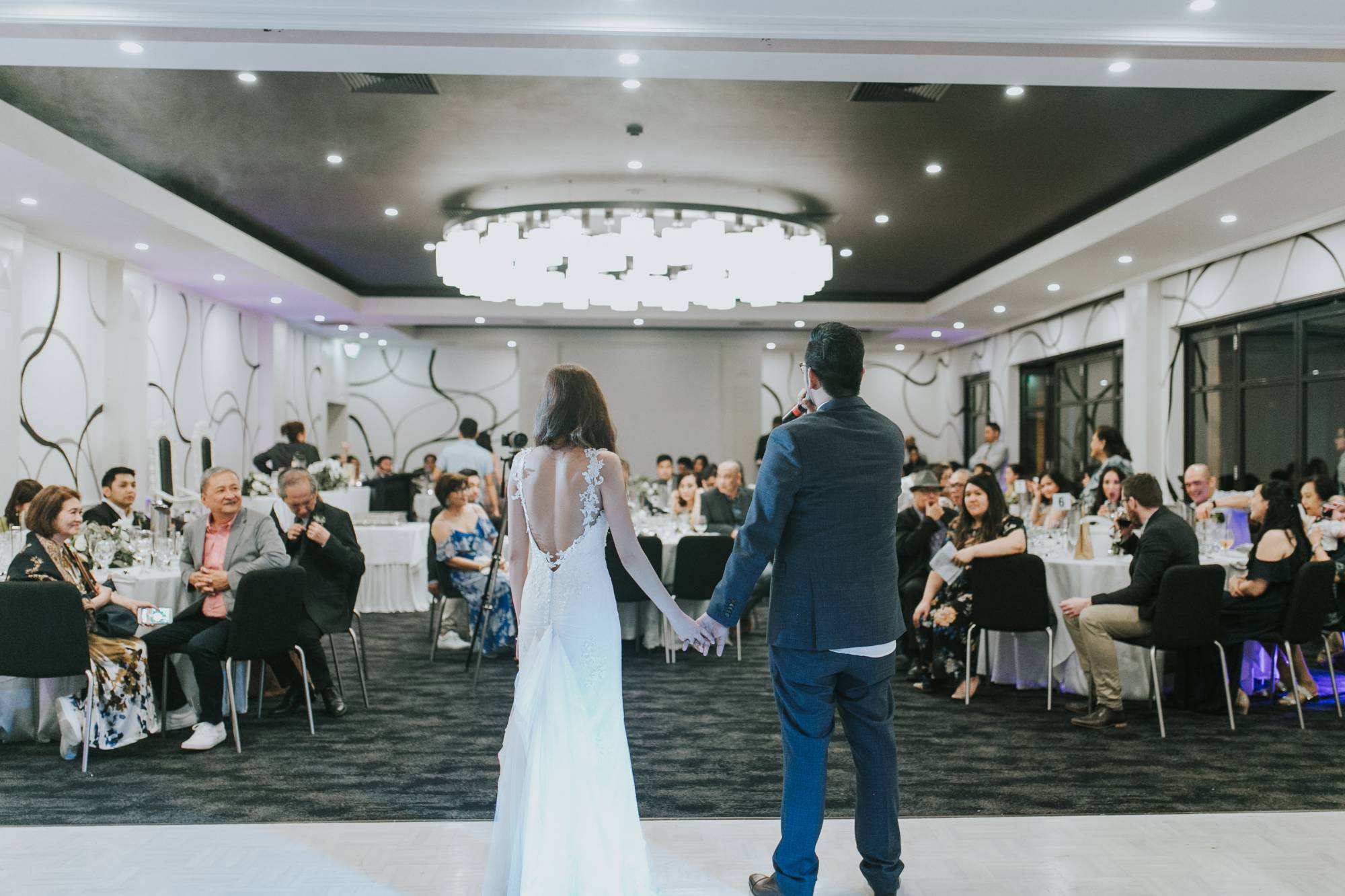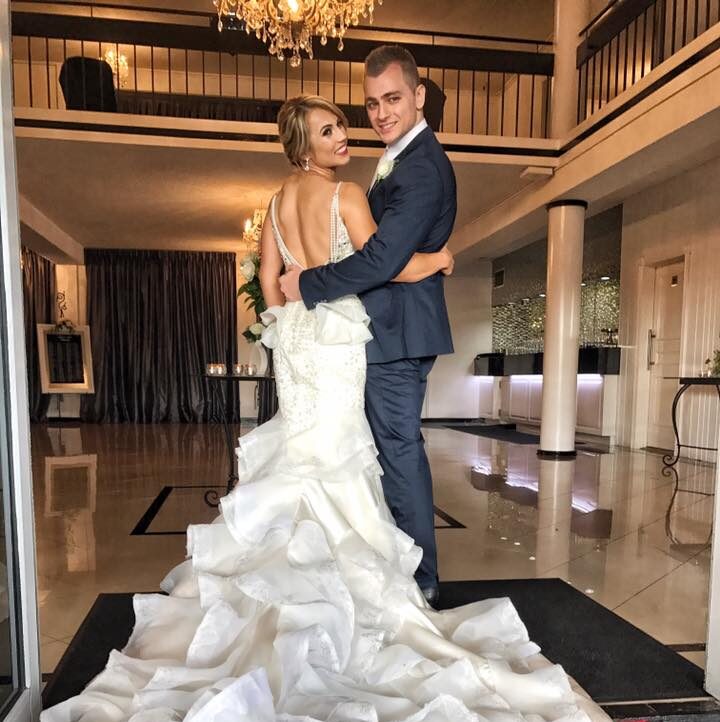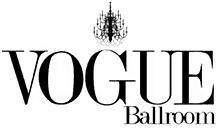Weddings are filled with memorable moments, but few are as emotionally charged as the couple’s first dance. It’s a moment that marks the beginning of your lifelong journey together, shared with your closest family and friends. But when should it take place during the reception? Should you take to the floor before dinner, or save it for after everyone’s had their fill?
In my own experience, this decision can be surprisingly tricky. When I got married at Vogue Ballroom, we debated timing, worried about what would “feel right” for us and our guests. Should we kick things off with a bang, or save it for later when everyone’s more relaxed?
There’s no one-size-fits-all answer, but by considering a few key factors—like the flow of the evening, your wedding style, and the vibe you want to create—you can make the first dance a moment to remember for the right reasons.
The Importance of Your First Dance at the Wedding Reception
The Emotional Power of the First Dance
Your first dance as a couple is more than just a moment to show off your dance moves—it’s an emotional, symbolic start to the celebration of your marriage. It’s that magical moment when time seems to slow, and the world melts away, leaving just you and your partner in the spotlight.
When I got married, the first dance was one of the most cherished moments of our reception. The crowd around us seemed to vanish as we shared that first twirl. For me, it wasn’t just about the dance—it was the perfect way to reflect on the vows we’d just made, surrounded by family and friends.
First Dance Wedding Reception Traditions
It’s also a fantastic opportunity to share something personal with your guests, whether it’s a song that means something special to both of you or a surprise dance routine that gets everyone talking. The first dance is a chance to set the tone for the rest of the evening, so it’s worth taking some time to think about what it represents.
Timing the First Dance Wedding Reception: Should You Dance Before or After Dinner?
Why Some Couples Choose to Dance Right After Reception Introductions
For some couples, the ideal time for the first dance is right after they’re introduced into the reception. This ensures that all eyes are on them, and the energy is high. When my partner and I were deciding on the timing of our first dance, we discussed this option. Having the first dance right after the introductions allowed us to get the “nervous” part out of the way early, leaving us free to relax and enjoy the rest of the evening.
The Case for Dancing After Dinner
Alternatively, dancing after dinner gives everyone a chance to relax and digest before the dancing starts. This allows your guests to fully focus on your moment without distractions. We decided to wait until after dinner for our first dance, and I can honestly say it worked out perfectly. Our guests were more relaxed and ready to let loose, and the energy on the dance floor was amazing.
Wedding Dance Songs: Choosing the Perfect First Dance Song
Personalising Your First Dance Song
Choosing your first dance song can feel like a big decision. After all, it’s a reflection of your journey together and the moment when everyone is focused on the two of you. When my partner and I were picking our song, we wanted something that spoke to our relationship, something that wasn’t just a catchy tune but had meaning.
We ended up picking a song that had been significant to us during our time together. For us, it wasn’t about choosing the “perfect” song—rather, it was about choosing something that felt right for us.
When you’re picking your song, think about the moments that have defined your relationship. Is there a song that’s meaningful to you both? Maybe it’s the song that played during your first date or a tune that reminds you of a special trip.
Personalising your first dance song can make the moment feel even more intimate. And remember, it doesn’t have to be slow and romantic—if an upbeat tune feels more “you,” then go for it!
Tempo and Style: Finding the Right Rhythm
While the song’s lyrics are important, the tempo can have just as much of an impact on your first dance. Do you want a slow, romantic moment or something more lively that gets your guests excited to join you on the dance floor?
We chose a slower ballad for our first dance, which matched the intimate, reflective mood we wanted. But some couples opt for an upbeat track that allows for a more playful and energetic routine.
Think about your wedding style as well. A formal black-tie wedding might suit a classic waltz, while a more casual celebration could benefit from a fun, modern tune. Don’t feel boxed in by tradition—if you and your partner prefer an unconventional song for your first dance, it will make the moment feel even more authentic.
Popular First Dance Wedding Songs
While it’s tempting to go for a unique choice, sometimes classic songs are the way to go. You can’t go wrong with timeless tracks like “At Last” by Etta James or “All of Me” by John Legend. These songs are crowd-pleasers and have been the soundtrack to many couples’ first dances.
But don’t feel pressured to follow the crowd. Whether you choose a song with personal meaning or something a little different, the most important thing is that it resonates with you both.
Wedding Dance Planning: Choreography or Freeform?
The Case for a Choreographed First Dance
For some couples, the idea of a perfectly planned first dance is very appealing. When I worked with a couple from South Melbourne who wanted their first dance to be a showstopper, they decided to hire a professional choreographer.
They spent weeks perfecting every move. It was a beautiful routine that flowed smoothly and impressed their guests. The energy on the dance floor was palpable, and their guests couldn’t stop talking about how stunning their performance was.
If you’re thinking about a choreographed dance, there are several benefits. First, it gives you a clear plan and helps alleviate any nervousness about what to do next. It also adds an extra layer of excitement and can make your first dance feel like a highlight of the evening. Plus, the guests love a well-executed dance number!
However, a choreographed routine requires time and practice, so you’ll need to commit to a few lessons in the months leading up to the wedding.
When to Keep It Simple: Freeform Dancing
On the other hand, many couples prefer to skip the choreography and let the dance flow naturally. When I got married, my partner and I decided to take the easy route and just enjoy the moment. We practised a few simple twirls and spins, but there was no complex routine.
We didn’t feel the need to impress anyone; we simply wanted to enjoy that precious time together. The simplicity allowed us to focus on the emotion of the moment rather than getting bogged down in steps.
If you’re not into dancing or want to keep things relaxed, freeform dancing is a great choice. You can still have an elegant first dance without feeling like you need to perform. Plus, if you’re nervous, a freeform approach gives you the freedom to move at your own pace and focus on each other rather than memorising complicated choreography.
Tips for Couples Who Want a Little of Both
If you like the idea of a choreographed first dance but don’t want the pressure of a full-on performance, you can always incorporate simple, elegant moves into your routine. A slow, graceful spin or a romantic dip can be just as impactful as a full dance number.
You can also surprise your guests by starting with a few basic steps and then moving into a more relaxed, freeform dance as the song progresses. This mix of structure and freedom keeps the moment spontaneous and memorable, without being overwhelming.
Other Key Wedding Dances: What Comes After the First Dance?
Father-Daughter and Mother-Son Wedding Dances
After the emotional first dance, it’s time for the parent dances. The father-daughter and mother-son dances are often some of the most heartfelt moments of the reception. When I worked with a couple from Essendon, the father-daughter dance was so moving that many guests were wiping away tears. These dances offer the bride and groom a chance to honour their parents and express gratitude for all their love and support.
The traditional sequence is for the bride to dance with her father, and then the groom dances with his mother. However, couples often make adjustments depending on their relationships.
For example, I’ve seen brides and grooms with divorced parents opt for separate dances with each parent. Others choose to do a joint parent dance, combining both the father-daughter and mother-son moments into one. Whatever you choose, it’s important to make these dances meaningful for you and your family.
Bridal Party and Group Dances to Energise the Reception
After the parents dance, some couples opt for a bridal party dance. This is a fun, high-energy moment where the couple shares a dance with their bridal party—often a way to show appreciation for their friends and family. I’ve seen this become an unexpected highlight at weddings! In one case, a bride and groom from Brighton led a bridal party dance where they switched partners throughout the song, keeping everyone laughing and engaged. It’s a great way to energise the crowd and get the party vibe going.
If you’re looking to really engage your guests, group or cultural dances can be fantastic additions. A Jewish Hora, a Greek Kalamatianos, or a traditional Mexican La Vibora de la Mar can get guests from different backgrounds onto the dance floor, celebrating culture and bringing everyone together.
These types of dances are especially effective if you have a lot of guests who don’t know each other, as they help break the ice and add excitement to the evening.
Anniversary Dance: A Sentimental Touch
One of my favourite wedding traditions is the anniversary dance. This dance honours long-married couples by inviting them to the dance floor and gradually eliminating couples based on how long they’ve been married. The couple that has been married the longest usually wins a prize, and it’s a wonderful way to highlight the longevity of love.
At a wedding I attended in Fitzroy, the oldest couple on the floor had been married for 60 years, and their love story was truly inspiring. It’s a tradition that creates a heartwarming break in the evening’s festivities and can lead to some very special moments.
How Long Should Your First Dance Be? Tips for Managing Dance Duration
Ideal Duration for Your First Dance Wedding Reception
One of the most common questions couples ask when planning their first dance wedding is how long it should last. I’ve seen first dances that were just a minute long and others that stretched to five minutes, and I can tell you from experience: shorter is often better.
Ideally, your first dance wedding should be between 1.5 to 2 minutes. This gives you enough time to savour the moment without losing the attention of your guests or cutting into the rest of the evening’s activities.
At my wedding, we chose a song that lasted about two and a half minutes. It was long enough to feel like we were truly embracing the moment, but not so long that it made our guests start to wonder when the dancing would shift to the next song. If you’re worried about the duration, remember this: the best moments are often the ones that feel like they happen quickly but leave a lasting impact.
Extending Your Dance with Live Music
If you’re working with a live band instead of a DJ, there might be more flexibility in the timing of your first dance. Live music can bring new energy to the floor and extend your dance beyond the usual 1.5 to 2 minutes. For example, if the band is playing an extended version of your chosen song or adds a little improvisation, it can work well if you feel comfortable. Just be sure that the length of your dance doesn’t disrupt the flow of the evening.
You don’t want to risk dragging on too long, especially since the first dance marks the beginning of the evening’s celebrations, and guests will soon be looking forward to enjoying the rest of the party.
Managing Dance Time During Choreographed or Freeform Dances
If you’ve opted for a choreographed first dance, it’s a good idea to rehearse with your partner to get a sense of how long the routine will take. Most choreographed routines are designed to last about 2 minutes, which fits nicely within the ideal first dance length. However, if you’re improvising or adding a few extra twirls and dips, it’s easy to get carried away.
My advice: keep the excitement going with a fluid transition into the next part of the reception, like moving right into the parent dances or the bridal party dance. This way, there’s a natural flow, and no one is left feeling like they’re just waiting for the dance to end.
Enhancing Your First Dance Wedding Reception Moment
Adding Special Effects for a Memorable First Dance Performance
If you want to elevate your first dance beyond the ordinary, incorporating special effects can make all the difference. At a wedding I attended in Carlton, they used cold sparks during the bride and groom’s first dance, and it was absolutely magical. The effect gave the dance a dramatic flair, making the moment feel even more cinematic.
From confetti blasts to CO2 guns or even a fog machine, adding a special effect at the right moment can transform your first dance into a truly unforgettable experience.
However, timing is key when it comes to these effects. Coordinate with your DJ or band to ensure the effect is synced perfectly with the music. For example, having confetti fall just as you hit the final pose or as the song peaks can add a beautiful visual element to an already emotional moment. Be sure to communicate with your venue about any restrictions on special effects, as some venues may have regulations due to safety concerns.
Event Design: Creating the Perfect Backdrop for Your Dance
The backdrop for your first dance is just as important as the choreography and music. A well-designed space creates a memorable visual that will look stunning in photos and videos. At my own wedding, we were fortunate to have a floral arch surrounding the dance floor, which made the moment feel even more intimate and special. Whether it’s a simple floral arrangement, elegant draping, or a striking piece of art, the right backdrop draws attention to the couple and enhances the atmosphere.
Lighting also plays a crucial role in setting the tone for your first dance. Soft, romantic lighting can create a warm, intimate vibe, while dynamic lighting can add energy to the moment.
I’ve worked with several couples who used spotlights to highlight the couple during their first dance, giving them the feeling of being in the spotlight. Just make sure that the lighting doesn’t distract from the moment but enhances the overall feeling you’re trying to create.
Coordinating the Space and Your Vendors
Planning the flow of the dance and the space surrounding it is essential. Ensure that there’s enough room on the dance floor for you and your partner to move freely, especially if you’re incorporating choreography. If your reception is in a venue with limited space, this is something to discuss with the event planner or venue manager to make sure the floor is cleared before the dance begins.
Work closely with your photographer and videographer, too. They will need to know the key moments for your first dance, especially if you’ve arranged special effects or unique lighting. A pre-wedding meeting is often a good way to get everyone on the same page.
This ensures that your photographers capture the perfect angles, and your videographer records every special moment, so you can relive the memory in years to come.
First Dance Wedding Reception Etiquette: How to Honour Your Guests and Make the Moment Shine
Announcing Your First Dance: Why It’s Important
Your first dance is a special moment for you as a couple, but it’s also a moment for your guests to share in the celebration. That’s why announcing your first dance is key. A good emcee or DJ will build the anticipation, letting guests know that something meaningful is about to happen.
When I attended a wedding in St Kilda, the emcee set the scene perfectly. He shared a few words about the couple, their journey, and what the song meant to them before inviting everyone to the floor. The entire room was captivated from the first note.
Having an announcement ensures that everyone knows when to focus on you, so you won’t feel like you’re dancing in a sea of distracted guests. It also sets the tone for the rest of the evening. You can use this moment to help create a more intimate atmosphere or ramp up the excitement if you’re looking for a bigger, bolder entrance.
Guest Participation: Keeping the Energy Going After the First Dance
Once the first dance concludes, the next goal is to keep the energy going and invite everyone onto the floor. After a sentimental first dance, your guests might be feeling a little emotional, so it’s important to shift the mood and get them excited to join in.
A great way to do this is by playing a high-energy song right after your first dance. I’ve seen couples invite their entire bridal party to join in after their parent dances, immediately creating a lively, fun vibe on the floor.
The key here is to make everyone feel included. A great DJ or live band will know just how to transition from the intimate to the party atmosphere. If you’re unsure about what song to play after your first dance, consider choosing something that’s universally loved and fun to dance to—something like “Dancing Queen” or “Uptown Funk.” This will get guests out of their seats and onto the floor, ready to join in the celebration.
Parent Dance Partnering: Honouring Family Traditions
In a traditional wedding, the bride typically dances with her father, and the groom dances with his mother. However, it’s important to remember that family dynamics can vary. If parents are divorced, remarried, or if you want to honour someone else, you can always adjust the dances to suit your needs.
I once worked with a couple where the bride and groom both had a step-parent they wanted to honour. Instead of following the typical order, they had a joint dance with both sets of parents, which made the moment even more meaningful for everyone involved.
What matters most is that the dances reflect your relationship with your family. This can be an emotional moment, so be sure to take the time to enjoy it. You can always skip certain traditions if they don’t fit your style, or combine them into something more unique and personal.
Tips for Your First Dance Wedding Reception Success
Planning Ahead for a Smooth First Dance Experience
Proper planning is key to a successful first dance. Even if you’re keeping it simple, it helps to practice a few times before the wedding day. When I worked with a couple in Richmond, their practice sessions really paid off—they were relaxed and confident when it was time to dance. If you’re planning a choreographed routine, start rehearsing a couple of months ahead of time to avoid feeling rushed.
Don’t Stress—Enjoy the Moment
The most important thing is to enjoy your first dance. The guests are there to celebrate your love, not to critique your moves. When I look back at my wedding, the joy we felt together is what stood out, not the perfection of our dance. Embrace the moment, even if it doesn’t go exactly as planned. It’s about your connection, not the choreography.




